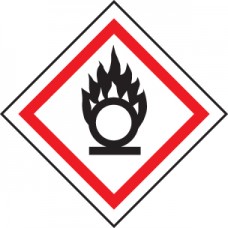Using GHS Labels for Oxidisers is essential to ensure clear and consistent communication of chemical hazards across workplaces, transportation, and storage facilities. These labels help identify substances that can greatly increase the risk of fire or explosion by supplying oxygen to support combustion. Because oxidisers may not be obviously dangerous on their own, the label serves as a critical warning to anyone handling or coming into contact with these chemicals, enabling them to take proper precautions.
One of the key reasons to use GHS oxidiser labels is to protect workers and emergency responders. By clearly marking containers and areas where oxidising agents are present, the labels alert personnel to potential dangers, helping them use appropriate personal protective equipment (PPE) and follow safety procedures. This awareness reduces the chances of accidental ignition, chemical reactions, or improper handling that could lead to severe injuries or property damage.
Another important benefit is that these labels promote safe storage and handling practices. Oxidisers must be kept away from flammable or combustible materials and stored under controlled conditions to prevent dangerous reactions. GHS labels guide users in segregating incompatible substances and inform safety training, helping maintain a safer environment. Without these clear visual warnings, there is a higher risk of accidents caused by mixing chemicals that can rapidly escalate fires or explosions.
Finally, the use of GHS oxidiser labels ensures compliance with international safety regulations and standards. Many countries require hazardous chemicals to be labeled according to the Globally Harmonised System to facilitate global trade, emergency response, and worker protection. Proper labeling not only avoids legal penalties but also fosters a culture of safety and responsibility in handling hazardous substances. In summary, GHS oxidiser labels are a vital tool for hazard communication, accident prevention, and regulatory adherence.
Material Options Explained
Below is a more detailed description of the materials this particular safety sign is available in. Helping you decide which sign option is most suitable for your application.
Rigid Plastic: This lightweight, gloss white PVC is resistant to weather, moisture, chemicals, and general wear and tear, making it suitable for harsh environments. Its smooth, solid surface allows for crisp printing of text and graphics, enhancing readability and visual impact. Businesses who choose Rigid Plastic signs benefit from fewer replacements and minimal maintenance, making it a practical investment for reliable and effective safety signs.
Self-Adhesive Vinyl: Self-adhesive vinyl is easy to apply and it’s budget-friendly. Its adhesive backing allows for easy application to a variety of surfaces such as glass, metal, plastic, and painted walls, which simplifies installation and reduces setup time. Self-adhesive vinyl provides a clean, professional finish that suits many indoor environments including offices, retail, industrial sites, and vehicles. It is more affordable than many other material types and allows for custom shapes, colours, and graphics.
GHS Labels - Oxidiser
- Brand: ISO Compliant
- Catalogue Page: 60 (EDITION 26)
- Availability: In Stock
Available Options
Related Products
Fire Escape Keep Clear
A Fire Escape Keep Clear Door Sign is important because it ensures that designated emergency exits r..
GHS Labels - Oxidiser
Using GHS Labels for Oxidisers is essential to ensure clear and consistent communication of chemical..
GHS Labels - Flammable
Using GHS labels for flammable substances is vital for clearly communicating the fire risks associat..
GHS Labels - Explosive
Using GHS Labels for Explosive Substances is essential for clearly identifying materials that pose a..
GHS Labels - Toxic
Using GHS Labels for Toxic Substances is crucial for clearly communicating the health hazards posed ..
GHS Labels - Corrosive
Using GHS Labels for Corrosive Substances is essential for clearly identifying chemicals that can ca..
GHS Labels - Health Hazard
Using GHS Labels for Health Hazards is vital for clearly communicating the presence of substances th..
GHS Labels - Environmentally Hazardous
Using GHS Labels for Environmentally Hazardous Substances is crucial for identifying chemicals that ..
GHS Labels - Irritant
Using GHS Labels for Irritant Substances is important for clearly identifying chemicals that can cau..
Tags: 14540U, 24540U, 58141, 58150, GHS, Shipping, Warning, Diamonds, Rolls, of, Labels, Harmful, Substance, Chemical, Hazard, Hazardous, Rigid, Plastic, SAV, Stickers, Label, Self, Adhesive, Vinyl,










